Jonathan Ho
Novel View Synthesis with Diffusion Models
Oct 06, 2022
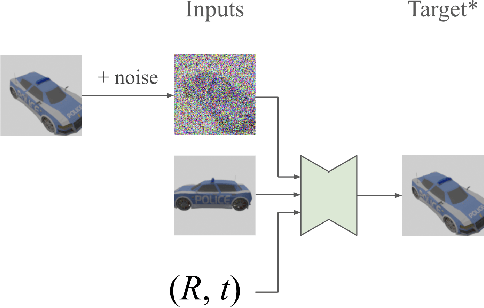
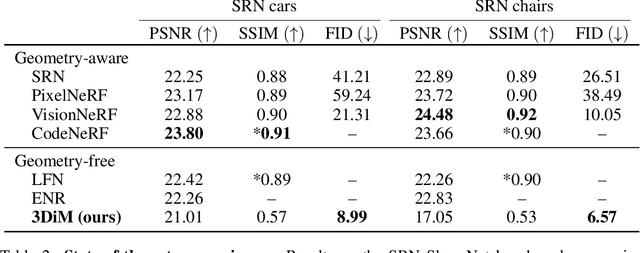
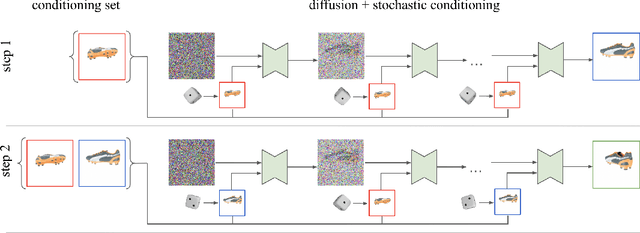
Abstract:We present 3DiM, a diffusion model for 3D novel view synthesis, which is able to translate a single input view into consistent and sharp completions across many views. The core component of 3DiM is a pose-conditional image-to-image diffusion model, which takes a source view and its pose as inputs, and generates a novel view for a target pose as output. 3DiM can generate multiple views that are 3D consistent using a novel technique called stochastic conditioning. The output views are generated autoregressively, and during the generation of each novel view, one selects a random conditioning view from the set of available views at each denoising step. We demonstrate that stochastic conditioning significantly improves the 3D consistency of a naive sampler for an image-to-image diffusion model, which involves conditioning on a single fixed view. We compare 3DiM to prior work on the SRN ShapeNet dataset, demonstrating that 3DiM's generated completions from a single view achieve much higher fidelity, while being approximately 3D consistent. We also introduce a new evaluation methodology, 3D consistency scoring, to measure the 3D consistency of a generated object by training a neural field on the model's output views. 3DiM is geometry free, does not rely on hyper-networks or test-time optimization for novel view synthesis, and allows a single model to easily scale to a large number of scenes.
On Distillation of Guided Diffusion Models
Oct 06, 2022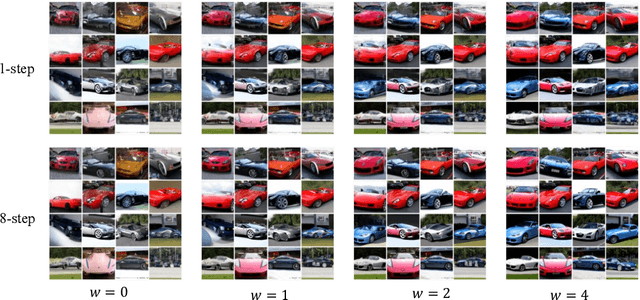


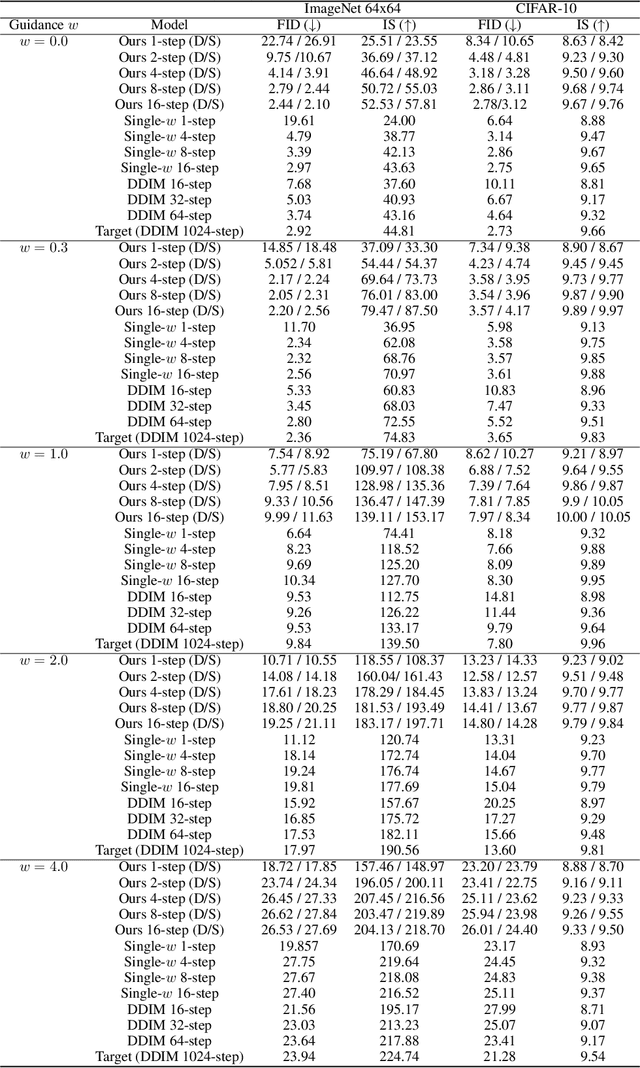
Abstract:Classifier-free guided diffusion models have recently been shown to be highly effective at high-resolution image generation, and they have been widely used in large-scale diffusion frameworks including DALL-E 2, GLIDE and Imagen. However, a downside of classifier-free guided diffusion models is that they are computationally expensive at inference time since they require evaluating two diffusion models, a class-conditional model and an unconditional model, hundreds of times. To deal with this limitation, we propose an approach to distilling classifier-free guided diffusion models into models that are fast to sample from: Given a pre-trained classifier-free guided model, we first learn a single model to match the output of the combined conditional and unconditional models, and then progressively distill that model to a diffusion model that requires much fewer sampling steps. On ImageNet 64x64 and CIFAR-10, our approach is able to generate images visually comparable to that of the original model using as few as 4 sampling steps, achieving FID/IS scores comparable to that of the original model while being up to 256 times faster to sample from.
Imagen Video: High Definition Video Generation with Diffusion Models
Oct 05, 2022

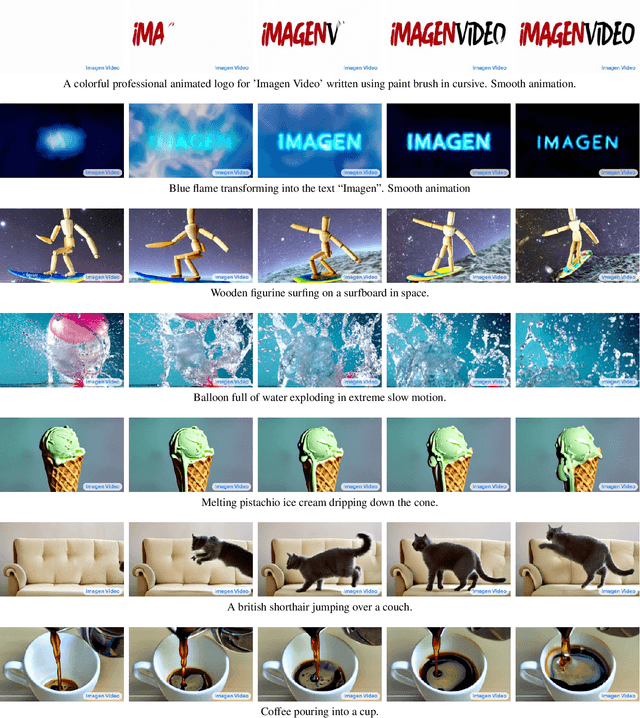
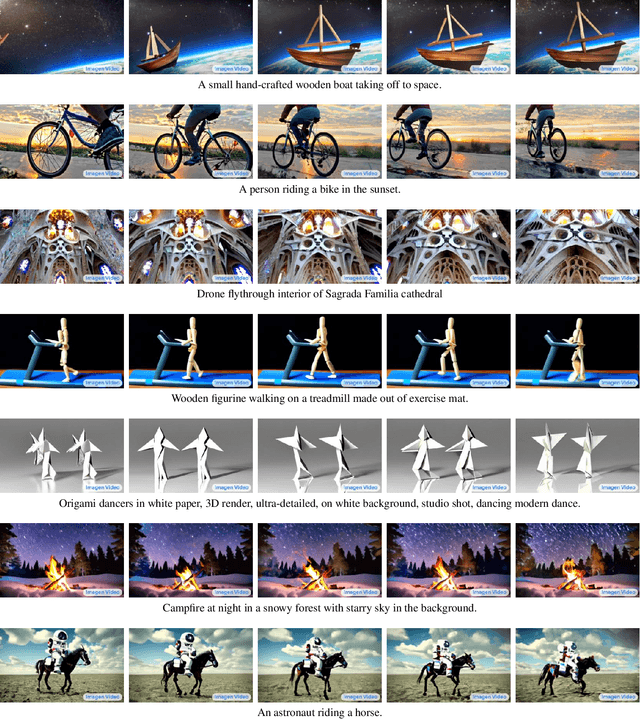
Abstract:We present Imagen Video, a text-conditional video generation system based on a cascade of video diffusion models. Given a text prompt, Imagen Video generates high definition videos using a base video generation model and a sequence of interleaved spatial and temporal video super-resolution models. We describe how we scale up the system as a high definition text-to-video model including design decisions such as the choice of fully-convolutional temporal and spatial super-resolution models at certain resolutions, and the choice of the v-parameterization of diffusion models. In addition, we confirm and transfer findings from previous work on diffusion-based image generation to the video generation setting. Finally, we apply progressive distillation to our video models with classifier-free guidance for fast, high quality sampling. We find Imagen Video not only capable of generating videos of high fidelity, but also having a high degree of controllability and world knowledge, including the ability to generate diverse videos and text animations in various artistic styles and with 3D object understanding. See https://imagen.research.google/video/ for samples.
Classifier-Free Diffusion Guidance
Jul 26, 2022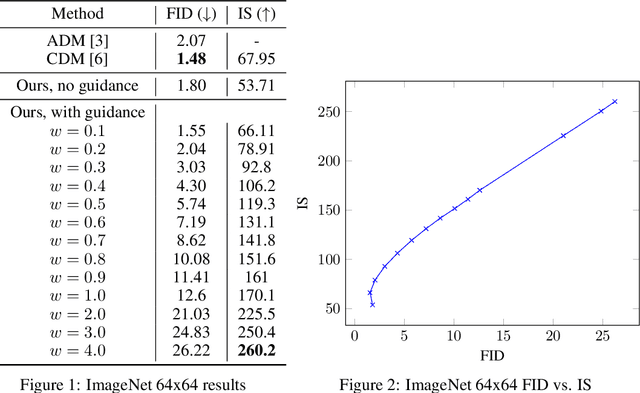

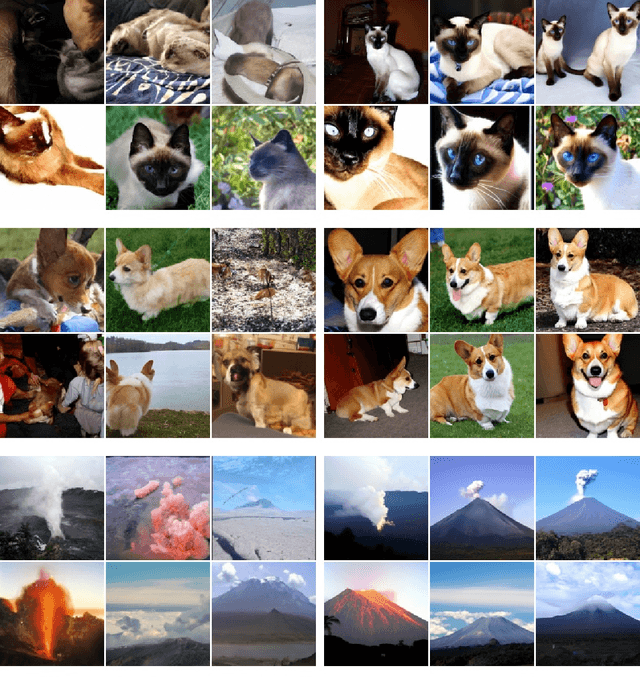
Abstract:Classifier guidance is a recently introduced method to trade off mode coverage and sample fidelity in conditional diffusion models post training, in the same spirit as low temperature sampling or truncation in other types of generative models. Classifier guidance combines the score estimate of a diffusion model with the gradient of an image classifier and thereby requires training an image classifier separate from the diffusion model. It also raises the question of whether guidance can be performed without a classifier. We show that guidance can be indeed performed by a pure generative model without such a classifier: in what we call classifier-free guidance, we jointly train a conditional and an unconditional diffusion model, and we combine the resulting conditional and unconditional score estimates to attain a trade-off between sample quality and diversity similar to that obtained using classifier guidance.
Photorealistic Text-to-Image Diffusion Models with Deep Language Understanding
May 23, 2022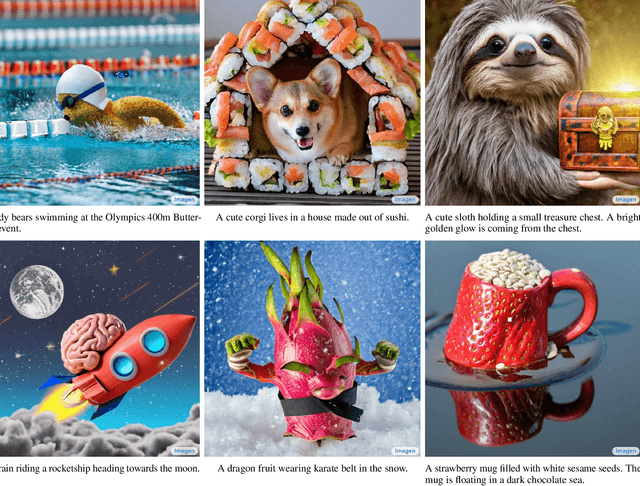
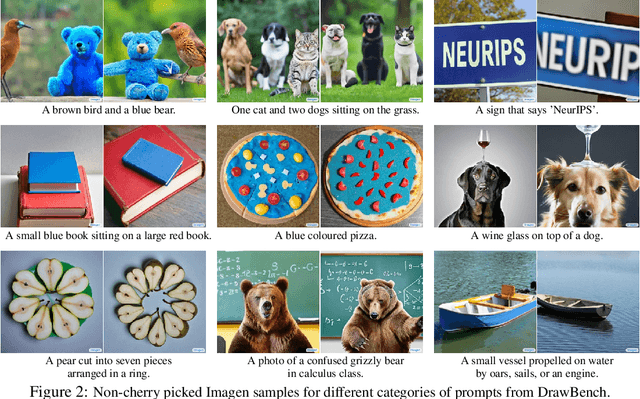
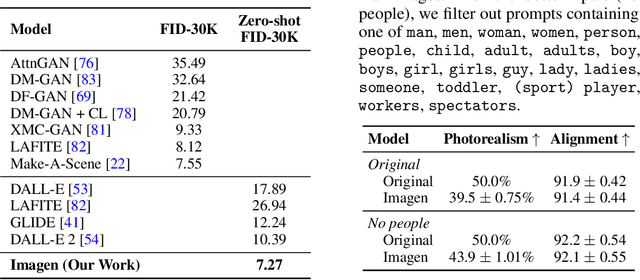

Abstract:We present Imagen, a text-to-image diffusion model with an unprecedented degree of photorealism and a deep level of language understanding. Imagen builds on the power of large transformer language models in understanding text and hinges on the strength of diffusion models in high-fidelity image generation. Our key discovery is that generic large language models (e.g. T5), pretrained on text-only corpora, are surprisingly effective at encoding text for image synthesis: increasing the size of the language model in Imagen boosts both sample fidelity and image-text alignment much more than increasing the size of the image diffusion model. Imagen achieves a new state-of-the-art FID score of 7.27 on the COCO dataset, without ever training on COCO, and human raters find Imagen samples to be on par with the COCO data itself in image-text alignment. To assess text-to-image models in greater depth, we introduce DrawBench, a comprehensive and challenging benchmark for text-to-image models. With DrawBench, we compare Imagen with recent methods including VQ-GAN+CLIP, Latent Diffusion Models, and DALL-E 2, and find that human raters prefer Imagen over other models in side-by-side comparisons, both in terms of sample quality and image-text alignment. See https://imagen.research.google/ for an overview of the results.
Video Diffusion Models
Apr 07, 2022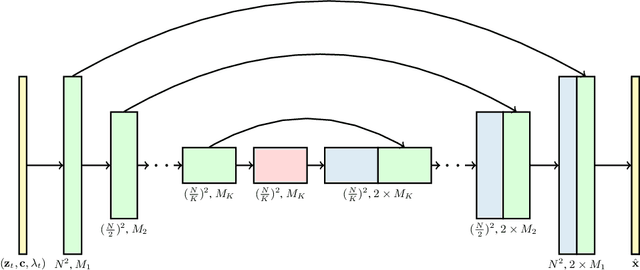
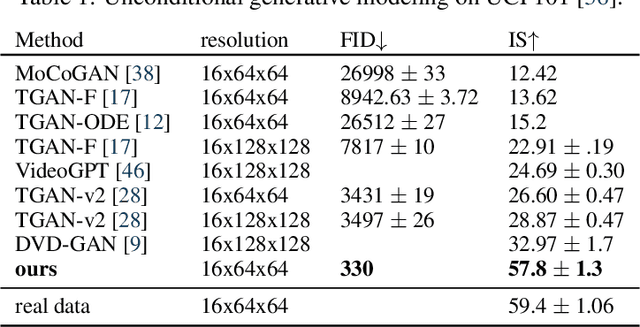
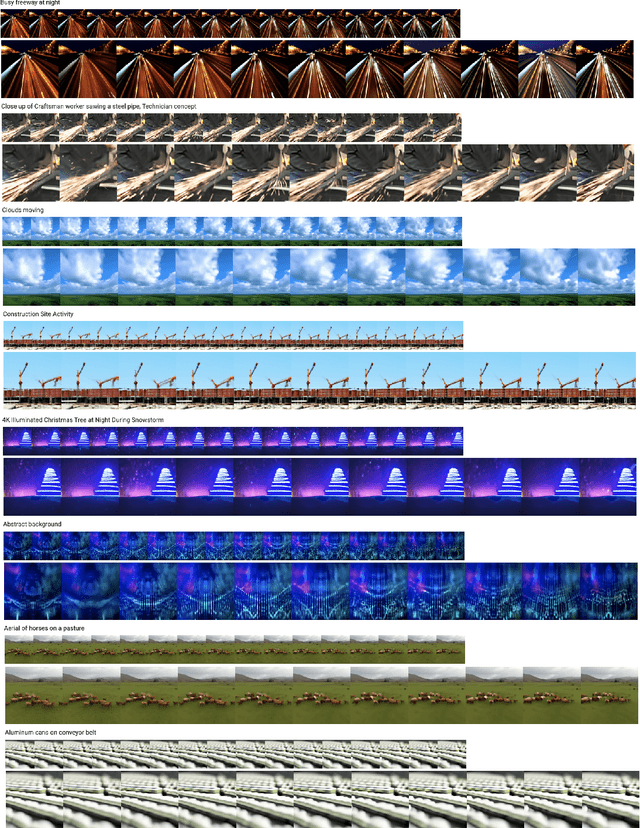

Abstract:Generating temporally coherent high fidelity video is an important milestone in generative modeling research. We make progress towards this milestone by proposing a diffusion model for video generation that shows very promising initial results. Our model is a natural extension of the standard image diffusion architecture, and it enables jointly training from image and video data, which we find to reduce the variance of minibatch gradients and speed up optimization. To generate long and higher resolution videos we introduce a new conditional sampling technique for spatial and temporal video extension that performs better than previously proposed methods. We present the first results on a large text-conditioned video generation task, as well as state-of-the-art results on an established unconditional video generation benchmark. Supplementary material is available at https://video-diffusion.github.io/
Learning Fast Samplers for Diffusion Models by Differentiating Through Sample Quality
Feb 11, 2022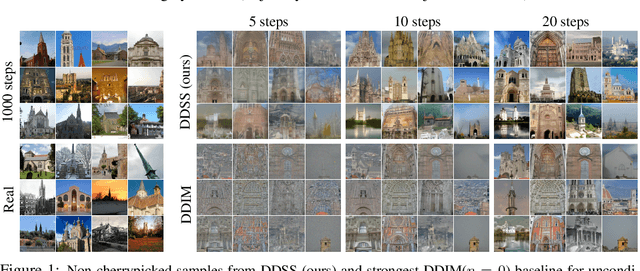



Abstract:Diffusion models have emerged as an expressive family of generative models rivaling GANs in sample quality and autoregressive models in likelihood scores. Standard diffusion models typically require hundreds of forward passes through the model to generate a single high-fidelity sample. We introduce Differentiable Diffusion Sampler Search (DDSS): a method that optimizes fast samplers for any pre-trained diffusion model by differentiating through sample quality scores. We also present Generalized Gaussian Diffusion Models (GGDM), a family of flexible non-Markovian samplers for diffusion models. We show that optimizing the degrees of freedom of GGDM samplers by maximizing sample quality scores via gradient descent leads to improved sample quality. Our optimization procedure backpropagates through the sampling process using the reparametrization trick and gradient rematerialization. DDSS achieves strong results on unconditional image generation across various datasets (e.g., FID scores on LSUN church 128x128 of 11.6 with only 10 inference steps, and 4.82 with 20 steps, compared to 51.1 and 14.9 with strongest DDPM/DDIM baselines). Our method is compatible with any pre-trained diffusion model without fine-tuning or re-training required.
Progressive Distillation for Fast Sampling of Diffusion Models
Feb 01, 2022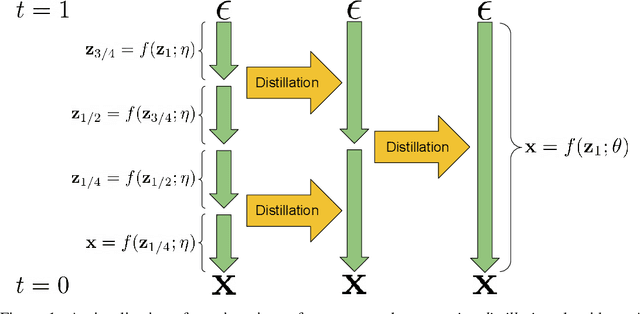
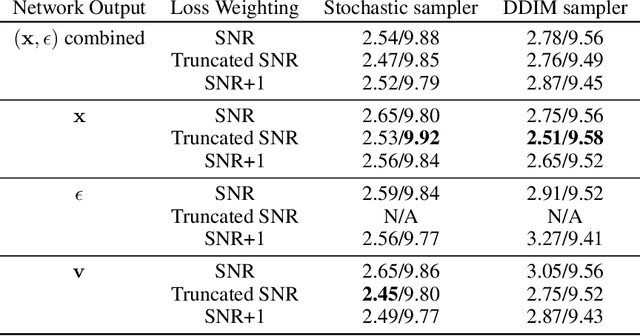
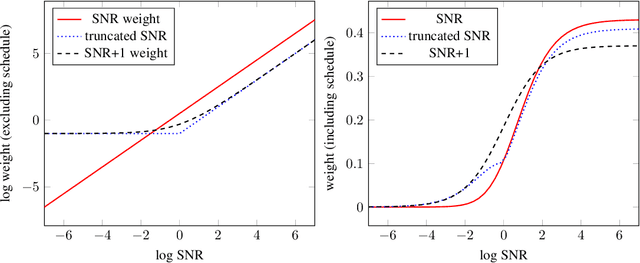
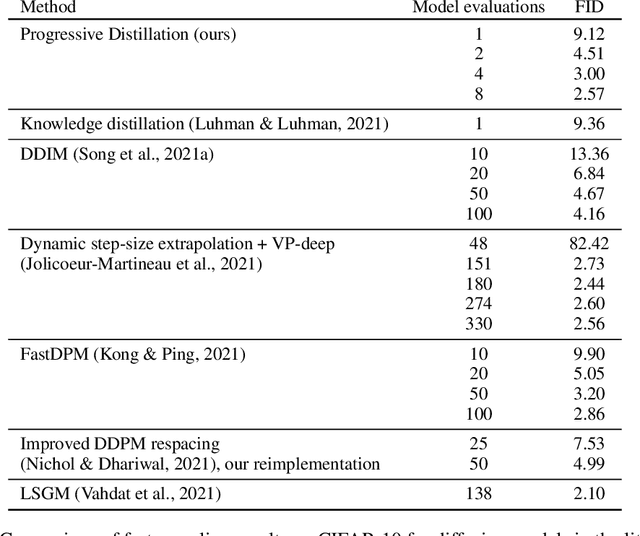
Abstract:Diffusion models have recently shown great promise for generative modeling, outperforming GANs on perceptual quality and autoregressive models at density estimation. A remaining downside is their slow sampling time: generating high quality samples takes many hundreds or thousands of model evaluations. Here we make two contributions to help eliminate this downside: First, we present new parameterizations of diffusion models that provide increased stability when using few sampling steps. Second, we present a method to distill a trained deterministic diffusion sampler, using many steps, into a new diffusion model that takes half as many sampling steps. We then keep progressively applying this distillation procedure to our model, halving the number of required sampling steps each time. On standard image generation benchmarks like CIFAR-10, ImageNet, and LSUN, we start out with state-of-the-art samplers taking as many as 8192 steps, and are able to distill down to models taking as few as 4 steps without losing much perceptual quality; achieving, for example, a FID of 3.0 on CIFAR-10 in 4 steps. Finally, we show that the full progressive distillation procedure does not take more time than it takes to train the original model, thus representing an efficient solution for generative modeling using diffusion at both train and test time.
Palette: Image-to-Image Diffusion Models
Nov 10, 2021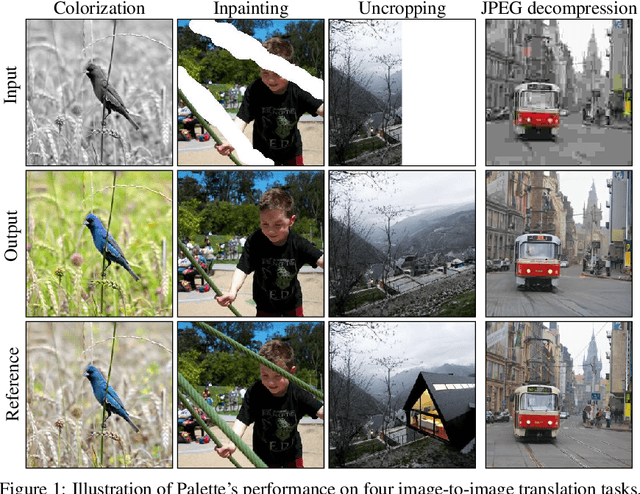



Abstract:We introduce Palette, a simple and general framework for image-to-image translation using conditional diffusion models. On four challenging image-to-image translation tasks (colorization, inpainting, uncropping, and JPEG decompression), Palette outperforms strong GAN and regression baselines, and establishes a new state of the art. This is accomplished without task-specific hyper-parameter tuning, architecture customization, or any auxiliary loss, demonstrating a desirable degree of generality and flexibility. We uncover the impact of using $L_2$ vs. $L_1$ loss in the denoising diffusion objective on sample diversity, and demonstrate the importance of self-attention through empirical architecture studies. Importantly, we advocate a unified evaluation protocol based on ImageNet, and report several sample quality scores including FID, Inception Score, Classification Accuracy of a pre-trained ResNet-50, and Perceptual Distance against reference images for various baselines. We expect this standardized evaluation protocol to play a critical role in advancing image-to-image translation research. Finally, we show that a single generalist Palette model trained on 3 tasks (colorization, inpainting, JPEG decompression) performs as well or better than task-specific specialist counterparts.
Structured Denoising Diffusion Models in Discrete State-Spaces
Jul 13, 2021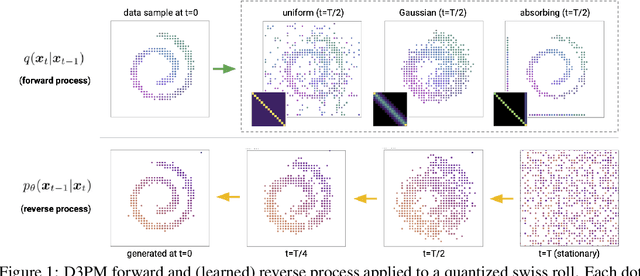
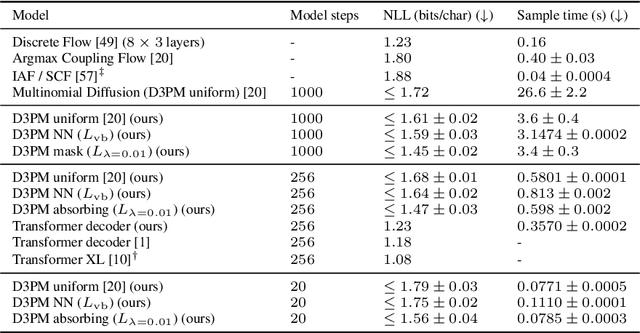


Abstract:Denoising diffusion probabilistic models (DDPMs) (Ho et al. 2020) have shown impressive results on image and waveform generation in continuous state spaces. Here, we introduce Discrete Denoising Diffusion Probabilistic Models (D3PMs), diffusion-like generative models for discrete data that generalize the multinomial diffusion model of Hoogeboom et al. 2021, by going beyond corruption processes with uniform transition probabilities. This includes corruption with transition matrices that mimic Gaussian kernels in continuous space, matrices based on nearest neighbors in embedding space, and matrices that introduce absorbing states. The third allows us to draw a connection between diffusion models and autoregressive and mask-based generative models. We show that the choice of transition matrix is an important design decision that leads to improved results in image and text domains. We also introduce a new loss function that combines the variational lower bound with an auxiliary cross entropy loss. For text, this model class achieves strong results on character-level text generation while scaling to large vocabularies on LM1B. On the image dataset CIFAR-10, our models approach the sample quality and exceed the log-likelihood of the continuous-space DDPM model.
 Add to Chrome
Add to Chrome Add to Firefox
Add to Firefox Add to Edge
Add to Edge